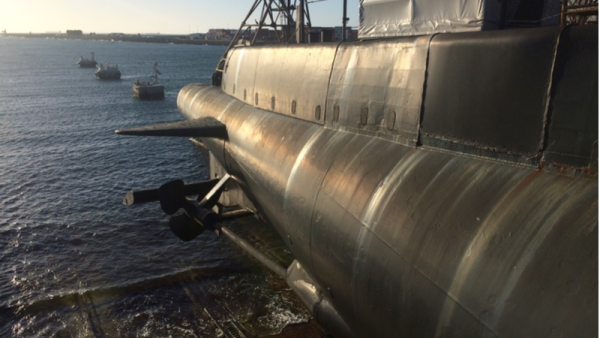The AUKUS nuclear submarine deal: Unanswered questions for Australia
EA Given / Shutterstock

Michael Clarke, Visiting Fellow, Australia-China Relations Institute, University of Technology Sydney |
This article appeared in The Diplomat on September 22 2021.
The announcement of the Australia-U.K.-U.S. (AUKUS) agreement for cooperation on Australian acquisition of nuclear-powered submarines (SSNs) – as well as closer cooperation between the three allies on artificial intelligence, cyber, quantum, underwater systems, and long-range strike capabilities – has generated an enormous amount of over-heated commentary.
For some, this agreement is something of a magical unicorn that will deliver all manner of strategic and security blessings onto Australia. Rory Medalf proclaimed that this ‘new triple near-alliance is based on capability, convergent interest and, above all, trust’ and will deliver ‘a merger of our military, industrial and scientific capabilities.’ These are bold claims.
Yet, for the submarine component of the agreement, at least, there remain a number of significant unanswered questions. What does this mean for Australia’s already strained submarine capability? For Australia’s capacity to establish the necessary infrastructure and technical know-how to build and maintain a fleet of SSNs? And is this acquisition aligned with a coherent strategy for the submarines’ use?
There is no doubt that the agreement constitutes a major shift in Australian policy. Most immediately, it presents an ignominious end to Canberra’s troubled $90 billion submarine deal with French-owned Naval Group for 12 diesel-electric powered Shortfin Barracuda (based on the French Suffren class) submarines and the beginning of a complex and potentially prolonged process to acquire eight nuclear-powered submarines (SSN) either of the U.S. Virginia class or U.K. Astute class.
The operational reasons for this switch are straightforward: SSNs will provide greater range and can stay at sea for longer and will therefore ‘transform the ability of the Australian Defence Force to operate at range around Australia and beyond.’ In a strategic context, SSN acquisition in cooperation with the United States and United Kingdom will also provide the Royal Australian Navy (RAN) with greater interoperability with both partners and redress what Prime Minister Scott Morrison termed the ‘narrowing’ of the ‘technological edge enjoyed by Australia and our partners’ in Asia.
The government’s rhetoric of urgency here, however, is somewhat belied by the realities of how long it will take to acquire the new submarines. Not only will the AUKUS partners engage in an intensive 18-month consultation to determine ’whether the British or American submarine is the best option, along with workforce, shipyard and training needs,’ but it is likely, as Morrison has himself noted, that construction would begin ‘within the decade’ and the first submarines would be in the water ‘before the end of next decade’ (i.e. the 2030s).
The scrapping of the Shortfin Barracudas, which were forecast to be operational by 2035, and their replacement with SSNs of as yet unknown design, means that Australia will engage in another life-extension of the six remaining Collins-class submarines, which are now due to be withdrawn from service in 2036. This, as Hugh White notes, combined with the likely long period it will take to either acquire an ‘off the shelf’ SSN from Australia’s AUKUS partners or to build them in Australia (as is the Morrison government’s preferred option), means that there is likely to be a ‘serious drop in capability in the 2030s’ as the Collins are withdrawn before the new SSNs become operational.
The government’s somewhat unconvincing response to this question is that Australia may look to lease SSNs from its AUKUS partners as a ‘stop gap’ solution. However if, as Morrison has claimed before, Australia lives ‘in a time of great uncertainty not seen since the 1930s,’ one would have presumed that such contingencies would not have been an afterthought.
The costs too of this acquisition are not known but it will be substantially more than the $90 billion that had been committed to the now scrapped Shortfin Barracuda. The Congressional Research Service assessed it costs approximately AU$4.73 billion (US$3.45 billion) to procure a Virginia class submarine but the Morrison government’s determination to build them in Australia and to develop ‘all the overheads involved in operating nuclear-powered submarines safely and responsibly’ will likely blow out that figure substantially.
The prospective AUKUS SSNs therefore come without ’any estimated cost (except they’ll be more expensive than the French ones), precise timetable (except they won’t be available for a couple of decades), or firm indication of how much building will be done in Australia (except that it won’t be all of it and possibly only a modest amount).’
We may also add questions about nuclear safety and nuclear proliferation to this list. What type of nuclear fuel will be used in the SSNs; will Australia obtain the fuel through purchase or domestic enrichment; and does Australia have the necessary scientific and technical capacity to adequately train submariners?
The most sensitive of these questions is that of nuclear fuel, as it impinges upon long-standing public divisions in Australia over the merits or otherwise of developing the civil nuclear industry and Canberra’s good standing as ‘champion’ of nonproliferation. Given that Australia ‘has no civilian nuclear power infrastructure beyond a 20 megawatt-thermal research reactor’ at Lucas Heights it is ‘likely to receive HEU technology’ from its AUKUS partners. That outcome may have ‘drops of sweat trickling down the neck the IAEA’ as it will ‘have to figure out how to monitor and account’ for such HEU ‘without gaining access to secret naval reactor design information.’
Finally, there remain questions over whether the proposed SSN capability is aligned with a coherent strategy – i.e. what objectives are the submarines designed to achieve – and what does that mean for Australian foreign policy? Both the Shortfin Barracuda and now the promised SSN acquisition suggest that the RAN ‘assumes that anti-submarine operations as part of a US-led sea-control campaign’ in the South China Sea, for instance, is Australia’s submarine fleet’s ‘primary role.’ But is this the best use of such an expensive and long-off Australian capability?
The answer to this question lies in the wager that arguably sits at the heart of the Morrison government’s decision.
While China was not mentioned in the AUKUS leaders’ announcement nor by Morrison, it has been obvious for over a decade that Canberra has wanted to find appropriate capabilities to hedge against what has been euphemistically termed by successive governments as the prospects for the ‘deterioration of the strategic environment’ due to Chinese assertiveness and expansion of its military and technological capabilities, including rapid building of a blue-water navy.
Back in 2009 when the government of Kevin Rudd slated the acquisition of 12 new submarines in its 2009 Defense White Paper, then-Defense Minister Joel Fitzgibbon stated that Australia required such capabilities to ‘adequately defend our maritime region, protect and support other Australian Defence Force assets, and undertake strategic missions’ with partners. This rationale remains, albeit leavened with a much greater public emphasis on the deterioration of the country’s strategic environment.
The SSN decision underlines the fact that the Morrison government has now openly sided with the American desire to maintain ’US strategic primacy in the Indo-Pacific region’ by posturing the RAN to play a role in what U.S. Secretary of Defense Lloyd Austin has framed as ‘integrated deterrence’ based on ‘integrated networks among our capabilities, our operations, and our allies.’
This, as Allan Gyngell notes, will make it ‘harder to disentangle our strategic commitments and our deep identification with the United States and Britain from our foreign policy interests’ and increase ‘US expectations of Australian support in almost any contingency, whether it involves China or not.’ At the very least the Morrison government is betting that the United States can sustain what the Biden administration has framed as ‘strategic competition’ with Beijing in Asia. However, in an era of fractured American domestic consensus on the need for continued American military extension abroad, greater reliance on the United States may not necessarily prove to be prudent.
Author
Dr Michael Clarke is a Visiting Fellow at the Australia-China Relations Institute at the University of Technology Sydney.

